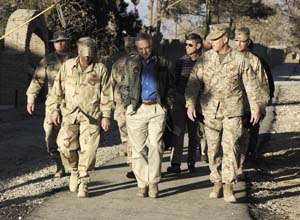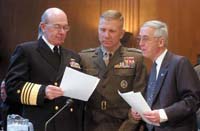Information Network Drives Navy Changes
 |
| Secretary of the Navy Gordon R. England (c) walks with U.S. Navy and Marine Corps officers and other personnel in Kabul, Afghanistan. Changes spearheaded by the Navy/Marine Corps Intranet are affecting the force transformation that defines Navy and Marine Corps operations on land, at sea and in the air. |
The U.S. Navy is discovering that enhanced connectivity is only the tip of the iceberg known as the Navy/Marine Corps Intranet. Unlike the frozen mountain that sinks ships, however, this iceberg is empowering a range of innovations that were not even on the sea service’s radar when the massive network was conceived.
As the Navy undergoes its transformation, it is redefining itself as a network-centric force. Virtually all elements of networking are represented in the capabilities of the Navy/Marine Corps Intranet (NMCI), and many of those are key enablers for the Navy’s force transformation. Disciplines ranging from information security to personnel staffing already are reaping the benefits of NMCI implementation.
When the NMCI is complete, it will be the second-largest information technology network in the world, after the Internet, observes Gordon R. England, secretary of the Navy. England states that the NMCI is the backbone for what the Navy does. It equips the department with access, interoperability and security for information and communications. Without it, the Navy would not be able to grow into the future.
The network serves as a key enabler even indirectly. Greater efficiencies in the “back end” of the service allow modernizations in the “front end,” the secretary declares. “The NMCI is an enabler in the back end of the business,” he says. “It is how you make the back shop more efficient so that we can put more fight in the front end.” As the Navy becomes more effective in the back end, it frees up money that can be applied to investment accounts for even greater effectiveness, he explains.
The widespread interconnectivity empowered by the NMCI allows the Navy to deploy enterprise-level applications such as the Naval Air Systems Command’s 2002 enterprise-resource planning system. England states that this system epitomizes the reasoning behind the NMCI. He describes its integration into the NMCI as a significant step in exploiting the tools and capabilities available through the network, particularly security.
The biggest effect that the NMCI has had on the Navy is that it has simplified the service’s operations, England offers. In the past, the Navy had so many disparate systems that it literally could not count them. The NMCI forces a management discipline in the process of implementation, he points out. “I’m not certain that everyone, even in our management structure, understands what we can accomplish today as opposed to before the NMCI.”
The systems being replaced by the NMCI were neither effective nor efficient, England observes. The Navy had 28 separate commands that were performing individual budgeting and were developing, licensing and operating information technology systems. These autonomous activities also limited the sharing of ideas and solutions that normally benefits a large organization. Similarly, the Navy did not have a common information technology infrastructure or management framework on which it could merge its efforts.
For example, the Navy recently stood up its new Commander, Navy Installations (CNI) command. Having the NMCI in place enabled the command to know the capabilities of all of the Navy and Marine Corps bases. It would have taken the Navy a long time to learn the operating systems at these bases prior to NMCI implementation, and this would have delayed the standup of the new command, England points out.
“It is essential for supporting our operations and our businesses,” he says. “So, it is essential for us that the NMCI work, and work effectively, because it is the way we will manage our business in the Department of the Navy in the future.
“There is a management discipline understanding that permeates our organization,” he continues. “Before, we had no idea of how numbers were generated, or of cross-checks or correlations or oversights. It has greatly simplified the way we manage the department.
“I would contend that we cannot manage the department without something like the NMCI,” England says.
The Navy has ordered about 340,000 seats for the NMCI, and it has 338,000 users online. About 170,000 seats already have been cut over to the Navy. Serving as a backbone are four network operation centers (NOCs) along with six classified and 27 unclassified server farms. England notes that this backbone has maintained service through fires, floods, blackouts and hurricanes.
The Navy struggled at times with NMCI implementation because the program is so large and complex, the secretary admits. Part of the problem concerned switching over from the different operating bases and their varying infrastructures. However, he believes that the program has turned the corner and now is accelerating toward completion.
The biggest challenge may have been in understanding the complexity of the NMCI baseline, he continues. The implementation proved harder for both the contractor and the customer than originally envisioned. Both sides underestimated the complexity of the task, so the program underwent a significant management restructuring. Both the Navy and EDS greatly expanded their management capabilities. Fortunately, both sides recognized the problem early enough to make useful mid-course corrections.
On the positive side, security has been a pleasant surprise. The vitally important security system has detected more than 2,000 new viruses on the network, and it has fallen victim to only one of them—the Welchia virus. Last year, the NMCI blocked almost 268 million access attempts at the NOCs, which works out to an average of more than 30,000 attempts per hour around the clock.
Another positive aspect that England cites is that the system’s discipline has helped replace tens of thousands of applications. All applications now must be approved through the Defense Information Technology Security Certification and Accreditation Program. Virtual private networking software is required for remote access; wireless solutions must comply with federal procurement and Defense Department standards; and firewalls must comply with Defense Department and Navy policy. The network incorporates public key infrastructure and password protection.
With the NMCI serving as a key enabler, the Navy faces a future defined by change. Currently, the sea service surges its forces daily. “We have people deployed every day around the world,” England observes. “So, what we want to do is surge people forward, support them better and get higher utility out of all of our systems.
“We would like to effectively grow the Navy with the same capability that we have today,” he declares. This can be achieved by having more ships on station and more people forward deployed with a greater surge capability. However, reaching that goal will require fully understanding how the systems work, the secretary notes.
The fleet currently has fewer than 300 ships, which is less than half of the target level of the 1980s. However, England warrants that no one in the Navy today would trade today’s fleet for the 600-ship 1980s fleet. Today’s capability is vastly superior to that of the larger fleet barely 20 years ago, he states.
In the late 1980s, the Navy had 102 ships forward-deployed. Today, the smaller Navy has roughly 90 ships forward-deployed—almost the same number. England emphasizes that the service gets much higher utilization rates from its ships today, and those ships are far more effective than their 1980s counterparts.
 |
| Prior to testifying before Congress on next year’s defense authorization, (l to r) Adm. Vern Clark, USN, chief of naval operations; Gen. Michael W. Hagee, USMC, commandant of the Marine Corps; and Gordon R. England, secretary of the Navy, review budget figures. For the future, the Navy may be increasing the number of ships in its fleet but reducing the number of people in service. |
Even with an increase in the number of ships, the Navy will see a reduction in personnel, the secretary says. In its most recent budget submission, the Navy has requested that Congress give it the authority to reduce the force by 8,000 sailors. Over the long term, personnel reductions will be concurrent with a constant upgrade in skills among those who remain. The result will be a greater number of people at higher skill levels and fewer people at lower skill levels.
For example, about 2,000 sailors manned the battleship USS Missouri in World War II. Today, an Arleigh Burke destroyer carries about 300 crew members. The DD(X) will crew about 125 people, and this ship class will have more automated and reliable systems. The result will be less time in shipyards and more time deployed, England points out.
Another shift in personnel will focus on nonmilitary jobs. England states that the Navy will be eliminating many of these nonmilitary positions or replacing them with civilians. “Managing our personnel, which is our most important asset, will be our biggest challenge,” he predicts.
At the heart of the NMCI lies information technology, and the most important information technology for the foreseeable future will be security-related, England declares. Maintaining the integrity and security of its systems is a top priority. The Navy will continue to be interoperable with the other services and Defense Department assets, which opens the door to broad arrays of data from outside the Navy. England notes that the service must stay in lockstep with its Defense Department counterparts, even for black programs. And, people always will be trying to penetrate these systems. Interoperability must be accompanied by security.
Many of these measures relate to homeland security, and the Navy is adjusting its information posture to address its new missions related to that challenge. The chief of naval operations has proposed the creation of a maritime version of the North American Aerospace Defense Command (NORAD). While Secretary England endorses the concept, the Navy has not fleshed out the details of how such a goal would be achieved.
An international maritime system that can track seagoing traffic around the world would be valuable, but no firm indications emerge as to its benefit versus its cost, he notes. Such a system would use the NMCI for its command center reach-back.



Comments